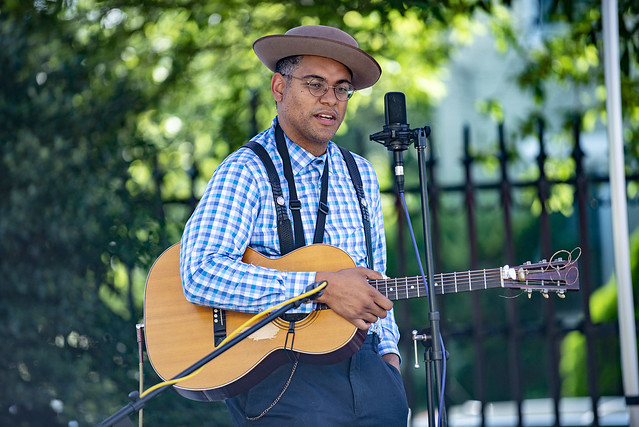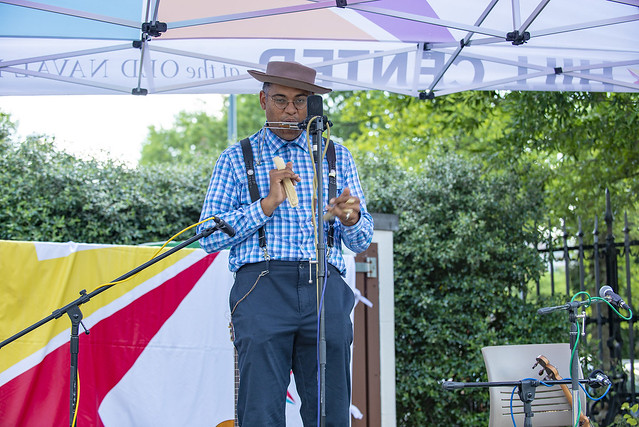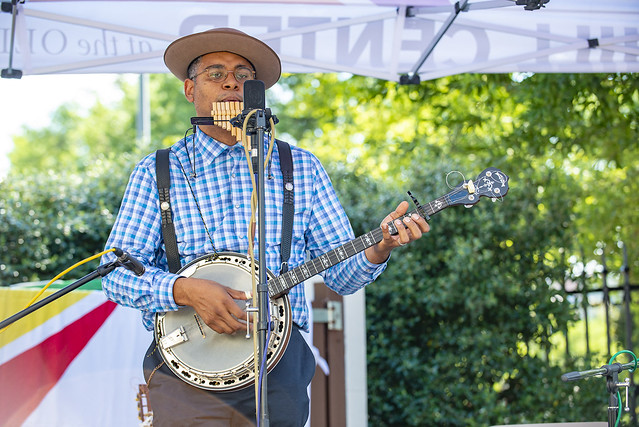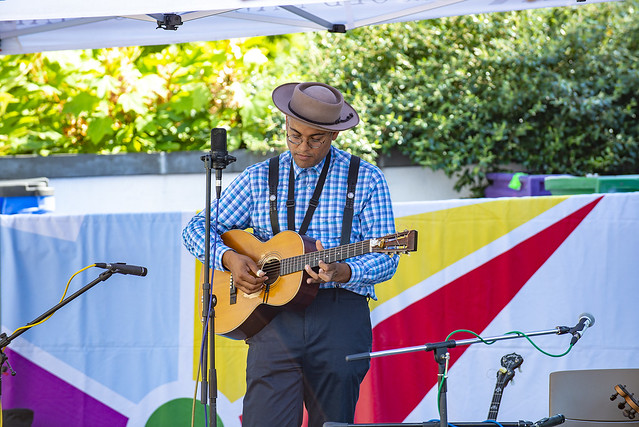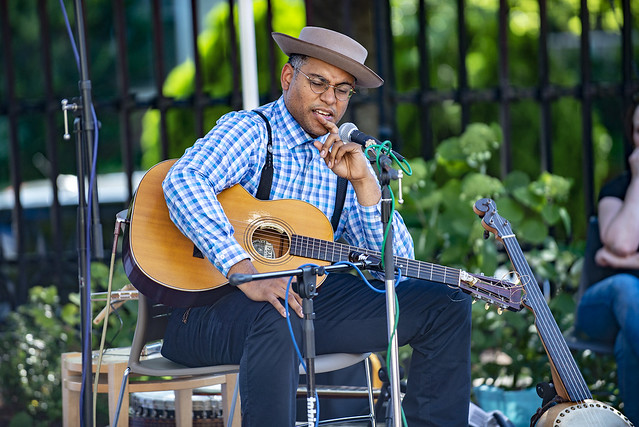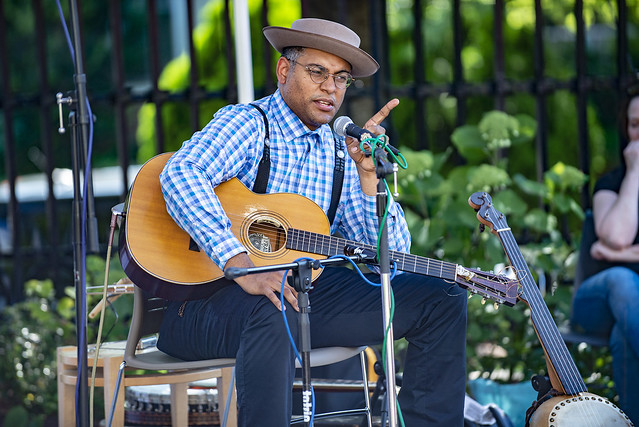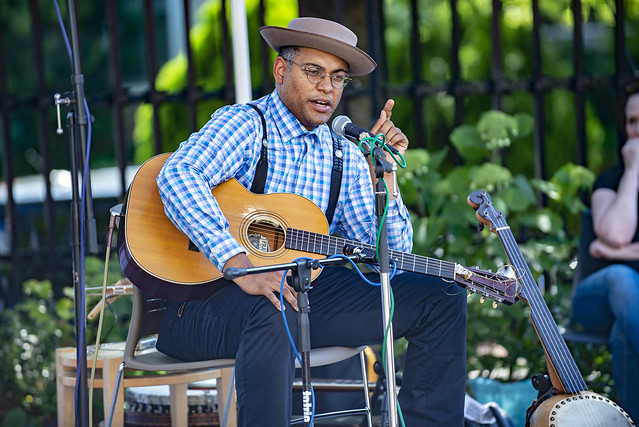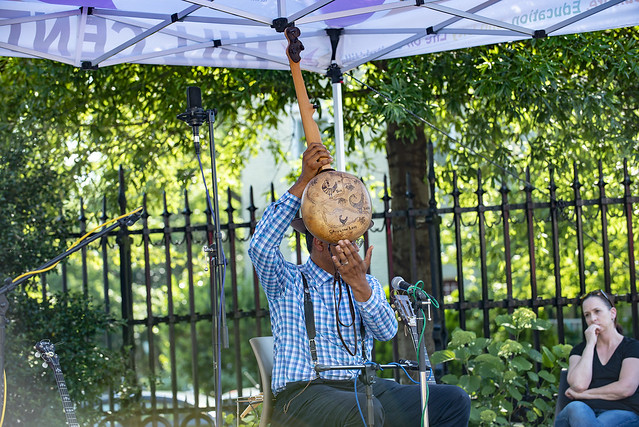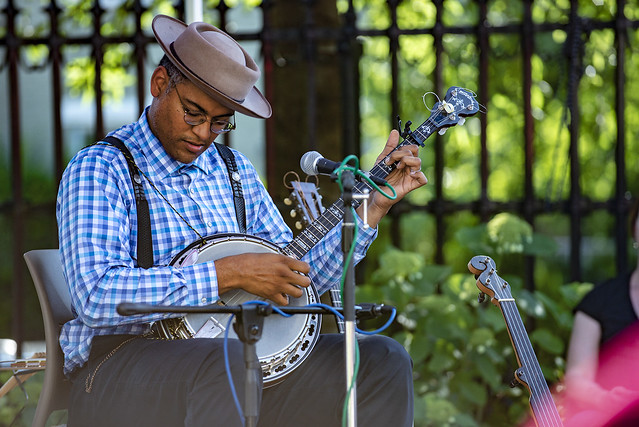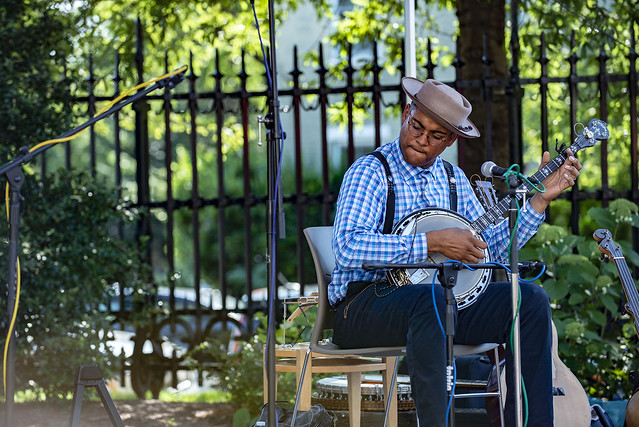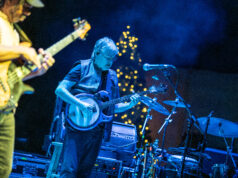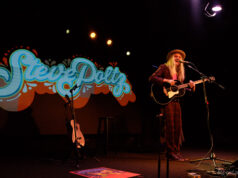
Dom Flemons performs at Hill Center on June 30, 2019. (Photo by Rashad Polk)
A show with Grammy Award winner and two-time nominee Dom Flemons was a journey through history and culture as much as a musical experience at Hill Center in DC recently.
By exploring the Black roots of American folk and popular music, Dom showed his audience how the “United States has always been multifaceted and culturally diverse.” His latest project, Black Cowboys, nominated for Best Folk Album, explores the many roles of African Americans in the history of the American West.
The atmosphere Sunday afternoon at the Hill Center, located at the Old Naval Hospital in the Eastern Market neighborhood, was decidedly laidback. Dom lives in Silver Spring, and his wife and adorable toddler accompanied him to the show on June 30. Casual greetings and reminiscences were exchanged before and after the concert. The audience overflowed the available seating, spreading out onto the patio and the lawn.
Read our Parklife DC interview with Dom Flemons.
The festivities kicked off at 4pm with Charlotte Harper, Director of Programming at the Hill Center, welcoming the audience to the show. She acknowledged the heat — it was about 90 degrees — and the lack of shade, and told everyone to help themselves to the water cooler. Then she invited Steve Winick, editor and folklorist at the Folklife Center at the Library of Congress, to the stage.
Later, Steve mentioned that he had decided to dress for the occasion, putting on his fanciest Western duds. He told the audience that his relationship with Dom, who makes extensive use of their archives, goes back to 2006. The Folklife Center, he said, has a lot of the Black cowboy songs that Dom researched for his album, such as Lead Belly’s rendition of “When I Was a Cowboy.”
Steve talked about the songster tradition. Songsters were traveling Black musicians who played every genre, the whole range of popular music. They were multi-instrumentalists who played the guitar, banjo, harmonica, and quills — and sometimes other instruments.
Finally, Steve mentioned that on Aug. 3, Dom will appear at the American Folklife Center for a Songster Jam. Then he introduced Dom, and the show really got cooking.
Dom started with a song he learned in Alamance County, North Carolina, from one of the last old time Black fiddle players, Joe Thompson. (Joe is an important thread in the tapestry of American music, and he was a fascinating person. It’s more than worth taking the time to look him up.) Dom played his arrangement of “Old Cindy Gal,” a fiddle and banjo tune, for the rhythm bones and harmonica.
Next, Dom played a song he learned from Henry Thomas of East Texas, “Charming Betsy.” He played the song on the quills, an instrument he learned from the late folklorist and musician Mike Seeger, half-brother of Pete.
Moving on to Bill and Charlie Monroe’s “Long Journey Home” on the banjo, Dom had the audience singing along to the chorus of “Lost all my money but a two-dollar bill.” Before the song, Dom spoke about how a Black fiddler and guitarist, Arnold Schutz, influenced the Monroes. Arnold gave the brothers their first paid gig. He passed his style of thumb picking on to Mose Rager, who taught it to Chet Atkins and Merle Travis.
On the first track of Black Cowboys, Dom chose to address the stories of the Black women who came out West. He said that they were often responsible for establishing the church and raising the standard of living. Dom performed “Black Woman,” also known as “Wild Ox Moan,” a capella. He found the song in the Library of Congress Archives. John Lomax, the great archivist of American song, originally recorded Vera Hall of Livingston, Alabama singing it in 1948. “Po’ Black Sheep,” which he played later in the set, also came from the Lomax archives.
Stream Black Cowboys by Dom Flemings on Spotify:
For the liner notes of Black Cowboys, Dom and his wife wrote 18 stories to follow 18 trajectories into the American West. One of those stories followed Nat Love, who was born into slavery. He moved to northern Arizona, where he became a cowboy. Later, when the land was fenced in — which he writes about with his disgust in his autobiography — he became a Pullman porter, like many other African Americans in that era.
Remarkably, Nat lived in the same small town, Holbrook, where Dom’s grandfather started a church in 1952. Dom worked his personal connection to Nat into “Steel Pony Blues,” which he played on the guitar. Encountering some resistance to his tuning, he remarked, “It’s better than the banjo. It usually gets the full TSA treatment.”
The Lone Ranger may have been based on a Black man, Bass Reeves, the first African American deputy U.S. marshal. Bass, who was born into slavery, made his home in Cherokee Territory, which later became Oklahoma, for 15 years. His familiarity with the land and people helped him get a commission. Dom included the great bluesman Lightnin’ Hopkins’s “He’s a Lone Ranger” on his record.
Dom displayed fingerstyle Piedmont guitarpicking on a medley of three songs: Elizabeth Cotten’s “Freight Train;” “Railroad Bill,” in the style of Etta Baker; and Leslie Riddle’s “Cannonball.” Dom only sang on the last. Leslie, who was best friends with bluesman Brownie McGhee, shared songs with A.P. Carter, shaping the development of country music.
Picking up his gourd banjo, Dom showed its artwork to the audience. It depicts Sankofa, an African proverb that means “go fetch it.” Dom said that he tries to follow this proverb in everything he does with music, fetching tradition and bringing it to contemporary audiences. Dom demonstrated the gourd banjo on “Old Corn Licker,” another song he learned from Joe Thompson. The gourd banjo is deeper and more resonant the standard instrument, with a mid-range tone. “It’s meant,” said Dom, “to evoke the sound of a banjo when it was a homemade instrument.”
Dom calls his giant six-string banjo “Big Head Joe.” Big Head Joe made his last appearance for a while on Sunday, as he’s in need of repair. The instrument is a historical relic; it was one of the banjos used when James Reese Jones broke the color barrier at Carnegie Hall. Dom used it to play “Keep on Truckin’,” a Blind Boy Fuller song he learned from Boo Hanks of Buffalo Junction, Virginia.
When Dom played at the Grand Ole Opry, he played a song, “There’s a Brown Skin Girl Down the Road Somewhere,” in the style of DeFord Bailey. DeFord, who was Black, was the first performer to appear on the Grand Ople Opry, and he played there frequently from 1927 to 1941. Dom mentioned as an aside that while he plays many instruments, one instrument he does not play is the fiddle.
Dom checked his pocket watch and saw that it was time to wrap up the show with a final song. He expressed his gratitude to Steve, whose help, he said, was invaluable in assembling the photos and stories for the liner notes to Black Cowboys. Dom closed his set with “Goodbye, Old Paint,” a traditional song that John Lomax recorded Jess Morris singing. Jess learned the song from an ex-slave.
It was a delightful afternoon of music and history. Dom is an incredibly talented multi-instrumentalist. He has a terrific stage presence, and the history he shares add vital color and depth. Dom opens new doors for his audience; hopefully, many of them will choose to walk through.
Dom’s Songster Jam at the Library of Congress on Aug. 3 is sure to be an equally good time, and is free and open to the public. Come on out for good times, good music, and good learning!
Here are some photos of Dom Flemons performing at Hill Center on June 30, 2019. All images copyright and courtesy of Rashad Polk.
